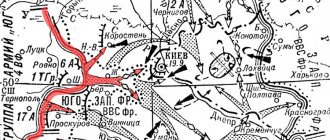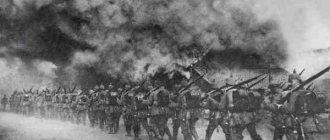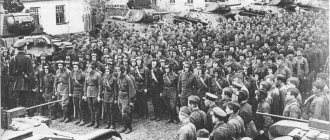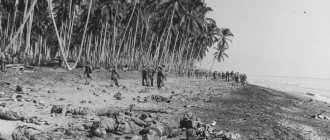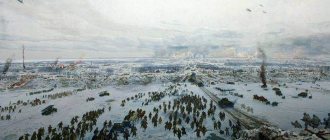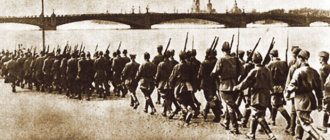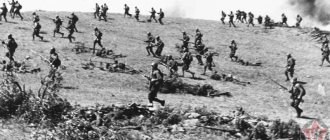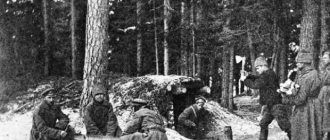Operation Rumyantsev is the final stage of the Battle of Kursk, which the troops of the Voronezh and Steppe fronts fought at the end of the summer of 1943. They were given the task of defeating the Kharkov-Belgorod group of Nazis, liberating the Kharkov industrial region and laying the foundations for the final liberation of the Left Bank of Ukraine.
The Voronezh Front was commanded by Vatutin, and the Steppe Front by Konev. “Commander Rumyantsev” operation date: August 3-23, 1943.
Operation "Rumyantsev" in brief
The plan for Operation Commander Rumyantsev initially envisaged the encirclement of the entire Wehrmacht group in the area of Kharkov and Belgorod. However, since this required serious forces and significant regroupings of troops, it was decided to abandon this “maximum plan”.
Operation “Commander Rumyantsev” – capture of Belgorod
As a result, the Soviet troops of Voronezh attacked with adjacent flanks, bypassing Kharkov. The pace of the advance was high - around one hundred kilometers for 3-4 days of advance.
Before the start of the attack battles, a campaign was carried out to misinform the enemy about the location of the main attack. They created an imitation of a concentration of Soviet tanks, thanks to which Manstein threw an additional armored division into the wrong area.
Operation "Commander Rumyantsev" map
Already on the third day of the offensive, the assault on Belgorod began. The German garrison defended itself staunchly, but by the evening of August 5, 1943, the city was cleared of the invaders. In Moscow, a fireworks salute was immediately given in honor of the liberation of Belgorod and Orel - the very first during the Great Patriotic War.
“Rumyantsev” WWII operation – liberation of Kharkov
The second main target of this offensive operation was Kharkov. The Germans built serious defensive lines around this city. The first line of them was at a distance of 8-14 km from the city. The second took place on the outskirts of Kharkov. Strong stone buildings were turned into fortified points and minefields were laid.
Kharkov was defended by seven infantry and two tank divisions of the Wehrmacht - although fairly battered in battle, they retained their combat effectiveness. They were reinforced by SS and police units. Adolf Hitler demanded that Manstein not seize Kharkov under any circumstances.
Red Army soldiers on the offensive
Soviet troops participating in the offensive operation "Rumyantsev" began to storm the outer defense line of Kharkov on August 11 and broke through it on August 13. In the following days, fierce and bloody battles broke out on the approaches to the city and its outskirts.
T-34 in Belgorod, August 1943
As a result of the general assault on the city, undertaken on the night of August 22-23, 1943, Kharkov was completely liberated from the invaders. In post-war Soviet Kharkov, the day of the end of Operation Rumyantsev - August 23 - began to be celebrated as City Day. One of the important streets, as well as the metro station located on it, was named “23 August”.
The Battle of Kursk ended with the victory of the Red Army
The Battle of Kursk ended with the victory of the Red Army over the Nazi troops on August 23, 1943 The Battle of Kursk and the subsequent strategic offensive of the Soviet troops according to the plan of the summer-autumn campaign marked the completion of a radical turning point in the course of the Great Patriotic War and, as a consequence, in the Second World War.
In the German offensive, by July 12, 1943, a crisis had matured; all possible mobile reserves were pinned down by the attacks of the Red Army forces; the need to stop the offensive and switch to defensive actions became obvious. The leadership of the German armed forces was tasked with holding their original positions at all costs.
The counteroffensive of the Red Army near Kursk had its own characteristics that distinguished it from the counteroffensive near Moscow and on the Volga. The armed struggle here assumed an even wider scope. Suffice it to say that all 5 tank armies that the Red Army had at that time, and 22 combined arms armies took part in the counteroffensive. If two fronts attacked near Moscow in 1941, and three on the Volga in the winter of 1942-1943, then near Kursk the counteroffensive was carried out by forces of five fronts.
After the start of the German offensive on July 5, the Headquarters of the Supreme High Command ordered almost all fronts to switch to active offensive operations. This was done in order to deprive the enemy of the opportunity to maneuver his reserves and transfer troops from other sectors of the front to the Kursk direction. The troops of the South-West and Southern Fronts played a particularly important role.
The Izyum-Barvenkovskaya offensive operation began on July 17, 1943 with attacks by troops of the Southwestern Front in order to pin down the enemy’s Donbass group and prevent the transfer of its troops to the area of the Battle of Kursk. The task of the mobile formations is to enter the breakthrough and strike in the direction of Stalino, in cooperation with the troops of the Southern Front, to encircle the Donbass group of Germans.
The Izyum-Barvenkovskaya offensive operation ended on July 27, 1943 . The enemy brought up its operational reserves - 17 and 23 tank divisions, as well as the SS Viking tank division, nevertheless, Soviet troops crossed the Seversky Donets, captured and expanded bridgeheads on its right bank, pinned down the German reserves, thereby providing significant assistance to the troops of the Eastern front in defense near Kursk.
The Mius offensive operation began on July 17, 1943 by troops of the Southern Front. The front was faced with the task of consistently defeating the opposing forces of the Sixth Army and diverting enemy reserves from the Kyp direction. The German command sent to the breakthrough area, in addition to the 16th motorized division, parts of the 23rd division, which was returned from halfway to Kharkov, as well as the 336th infantry division, and significant aviation forces were urgently transferred from the Belgorod-Kharkov direction to the Donbass.
From near Kharkov to the bridgehead area on the right bank of the Mius on July 29, 1943, the 2nd SS Panzer Corps was redeployed as part of the tank divisions: “Dead Catch”, “Reich”, as well as the third tank division. In the current situation, the troops of the Southern Front were unable to break through the heavily fortified enemy defenses and break into the center of Donbass. An order was received to retreat to the left bank of the Mius.
The Mius offensive operation ended on August 2, 1943 . Soviet troops not only deprived the enemy of the opportunity to transfer divisions from Donbass to the Kursk Bulge, but also forced them to withdraw up to five tank divisions from the Belgorod-Kharkov direction, as well as large aviation forces, and abandon all this to hold their positions in Donbass.
Offensive operations near Orel and Kharkov unfolded on a front exceeding 600 kilometers, and troops from five fronts took part in them. By the time the assigned tasks were completed, the depth of operations reached 180 kilometers.
Even when organizing and planning the defense of the Kursk salient in March 1943, the Headquarters of the Supreme High Command provided for the transition of the left wing troops of the Western, Bryansk and Central Fronts to the offensive.
The Western Front under the command of Colonel General Vasily Sokolovsky and the Bryansk Front under the command of Colonel General Markian Popov on July 12, 1943 went on the offensive according to a pre-developed plan under the code name “Kutuzov” against the 2nd Tank and 9th armies of the Germans in the city area Orla. The plan also provided for the participation of troops of the Central Front in an offensive from the Ponyri and Arkhangelskoye areas.
Soviet troops completely liberated Orel on August 5, 1943 . By this time, the enemy defenses on the Oryol bridgehead had been broken through and the Germans began a hasty retreat to the Hagen defensive line east of Bryansk. In Moscow on this day, the first fireworks display of the entire war was given - in honor of the liberation of Orel and Belgorod.
August 3, 1943, on the southern front of the Kursk salient, a strategic offensive began according to the developed plan under the code name “Commander Rumyantsev” by the forces of the Voronezh and Steppe fronts. As part of the “Belgorod-Kharkov strategic offensive operation”, the Belgorod-Bogodukhovskaya and Belgorod-Kharkovskaya frontal offensive operations were carried out.
During the Belgorod-Bogodukhovskaya operation on August 5, 1943, at approximately 18:00, Belgorod was liberated. Developing the offensive in the Belgorod-Kharkov operation, Soviet troops cut the Kharkov-Poltava railway. The German counterattacks were unsuccessful.
Since the main forces of the Soviet Army were concentrated in the area of the Kursk ledge, Headquarters temporarily suspended offensive operations in the northwestern direction. Only in July, during the Battle of Kursk, they decided to carry out the Mginsk offensive operation. The fighting was fierce, and the German 18th Army had no reserves left in the Porechye area.
A little more, and the breakthrough area could have been expanded. But reports began to come from unit commanders that the Nazis’ resistance had suddenly increased sharply. It turned out that the Nazi command completely removed two divisions from Leningrad, intended for the assault on the city, and plugged the hole with them in order to localize the breakthrough, preventing it from turning into a wide gap. As a result, the Germans used all their reserves to hold their positions and were unable to transfer part of the forces of Army Group North to Kursk.
By the beginning of August 1943, the general situation on the Soviet-German front, including in the western strategic direction, was determined by the victories won by the Soviet Army near Kursk. It was important for the Soviet command to defeat as many enemy forces as possible through active actions in other directions in order to prevent him from using these forces to counter the counteroffensive of the Red Army.
The headquarters of the Supreme High Command prepared a major offensive operation, which received the code name “Suvorov” and began on August 7, 1943 with the offensive of the troops of the Western and left wing of the Kalinin fronts. Close interaction between fronts and prompt response to the situation became a distinctive feature of the summer-autumn offensive. Soviet troops created tension in one of the directions and forced the German command to pull reserves there, transferring them from other fronts. The Red Army immediately launched an attack on the weakened area.
with the offensive of the right wing of the Southwestern Front on August 13, 1943 . Three days later, having broken through the German defenses, the troops of the Southern Front went on the offensive. The successful development of hostilities on the northern and southern fronts of the Kursk strategic bridgehead created favorable conditions for striking from its top at the junction of the German Army Groups “South” and “Center”.
It was planned to use this opportunity even when planning the summer campaign of 1943. The attack on Kharkov, Poltava, and Kyiv was, in the opinion of the General Staff, the most promising. The idea of defeating the southern enemy group did not affect the main, western strategic direction. Army Group Center would threaten the flanks of the advancing fronts.
In an atmosphere of secrecy, the Headquarters of the Supreme High Command, during the offensive operations of the Battle of Kursk, gave a directive for the offensive of the Central Front in the general direction of Konotop, Nizhyn, Kyiv. Already on August 20, 1943, the command of the Central Front reported to the General Staff the plan for the Chernigov-Pripyat operation, which was approved on August 22. However, as at Kharkov, the enemy put up serious resistance - the Wehrmacht still had hope of changing the course of the war and returning lost territories.
German total casualties by the end of the operation were around 321,000. The epochal battle ended with the almost complete liberation of Left Bank Ukraine from German troops and the capture of bridgeheads on the right bank of the Dnieper. The radical turning point in the war that occurred during the Battle of Kursk was finally completed. By the morning of November 6, the capital of Soviet Ukraine, the city of Kyiv, was liberated.
As a result of the defeat of significant Wehrmacht forces on the Soviet-German front, more favorable conditions were created for the deployment of American-British troops in Italy, the disintegration of the fascist bloc began - the Mussolini regime collapsed, and Italy came out of the war on the side of Germany. Under the influence of the victories of the Red Army, the scale of the resistance movement in the countries occupied by German troops increased, and the authority of the USSR as the leading force of the anti-Hitler coalition strengthened.
Belgorod-Kharkov offensive operation - results
The Belgorod-Kharkov operation of the Soviet troops achieved its main goals. The enemy was expelled from the cities of Belgorod and Kharkov, and suffered significant losses. The liberated territories became a springboard for the future final liberation of Donbass and Left Bank Ukraine.
In liberated Kharkov, August 1943.
Several formations of the Red Army received the honorary names “Belgorod” and “Kharkov”, and were also transformed into guards. Over 180 soldiers and commanders won the high ranks of Hero of the Soviet Union in Operation Rumyantsev.
Operations “Kutuzov” and “Commander Rumyantsev” were the victorious conclusion of the Battle of Kursk. As a result of the first, Orel was liberated, the second - Belgorod and Kharkov.

